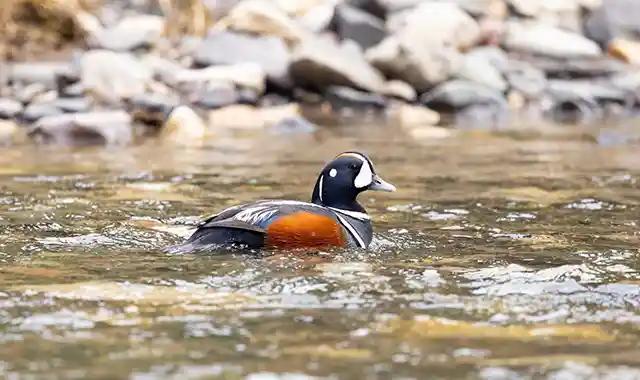
Harlequin Duck, Credit: NPS, Jacob W. Frank
Harlequin Ducks can be found across North America, split into two distinct populations, one on the West Coast and one on the East Coast. In the west, the species nest in remote, mountainous, rushing streams in dense forests from Alaska to southern Oregon and extending inland to Montana and Wyoming. After breeding, they migrate to rocky shorelines along the north Pacific coast, where they molt and winter. The remote nature of these habitats makes the species difficult to study, resulting in gaps in scientists’ understanding of their breeding ecology, populations, and movement patterns.
Small breeding populations in many states and Canadian provinces have also led to the western population being identified as a sensitive species/species of greatest concern in British Columbia, Alberta, Northwest Territories, Nunavut, Yukon, Washington, Oregon, California, Wyoming, Montana, and Idaho. A clear need for additional information on the population dynamics of the species among their breeding, molting, wintering, and staging areas emerged as conservation entities across the West began considering how to manage the species best and improve Harlequin Duck population health.
Existing data on Harlequin Duck movement consists primarily of capture-mark-recapture and radio telemetry studies. Most of these studies are limited in their geographic extent and don’t offer the same degree of detail into the species’ movement characteristics as continuous tracking technology such as satellite telemetry. Only a handful of satellite telemetry studies have been conducted on Harlequin Ducks, mostly focused on the eastern North American population. In an effort to help fill existing data gaps for the western population, Andrew Annanie, a graduate student at Western Washington University, brought together colleagues and satellite telemetry datasets from multiple states and Canadian provinces to use as the basis for his thesis on large-scale Harlequin Duck migration ecology and connectivity across western North America.
After earning his Bachelor’s degree from the University of Washington in 2012, Andrew worked for the Washington Department of Fish and Wildlife as a seasonal technician for several years, participating in a variety of fisheries, waterfowl, and seabird-related projects. Afterwards, he worked for the Quinault Indian Nation, where he did a diversity of field biology work on waterfowl, large predators, elk, mountain goats, sea otters, and most importantly, video surveys for breeding Harlequin Ducks.
This eventually led to his master’s project, supervised by Dr. John Bower, Dr. John McLaughlin, Dr. Sean Boyd, and Joe Evanson, with significant contributions provided by Kate Martin of the Sea Duck Joint Venture and David Douglas of the USGS. The primary goals of the study were to document Harlequin Duck populations and compare their migration timing, migratory connectivity, and how geographic and climate variables affect their migration timing. The study also looked at how loyal birds were to specific breeding, moulting, wintering, and stopover sites, and looked at how long breeding pairs were separated, where they separated and reunited, and how much time they spent together versus apart. The project incorporated three different satellite telemetry datasets: one from British Columbia, one from Alberta, Montana, Washington, and Wyoming, and a historical dataset collected from Alaska. In total, the study included data from 136 birds, making this the largest study on the topic in terms of sample size and geographic extent.
Using a combination of spatial and statistical analysis techniques, the research team found that Harlequin Duck migration timing varied based on factors such as the sex of the ducks, the region where they breed or were captured, and local environmental conditions. They also found evidence of a clear timeline among breeding regions for breeding arrival, breeding departure, moulting arrival, and wintering departure dates.
Specifically, ducks from the Cascade and Olympic Mountains and Vancouver Island arrived and left their breeding sites earlier than those from the Rocky Mountains and Mackenzie Mountains. Additionally, factors such as geographic location, elevation, the distance traveled, and local weather conditions significantly influenced the timing of each migratory stage – breeding, wintering, and molting, especially when it came to the dates they arrive at and leave their breeding sites.
Interestingly, the study also found that birds from the same breeding region had a more consistent, structured migration timing compared to those from the same wintering region. This suggests that the location where they breed affects their migration schedule more than where they spend the winter across multiple life stages. The team believes this is partially because the breeding season is shorter for birds nesting at higher elevations and/or more northern latitudes, which tend to have a smaller window where breeding conditions are favorable.
Further, they found migratory connectivity was low among the different life stages of the duck – breeding, moulting, and wintering. This indicates that ducks from various areas mixed as they moved between life stages. While some past studies have speculated on this, Andrew’s work is the first to show this directly.
The findings also highlight that the specificity of breeding timing may be cause for concern, as climate shifts have been altering weather patterns and habitat availability in breeding areas. Understanding these migration patterns can help scientists identify key habitats for Harlequin Ducks and inform region-specific management. Additionally, the research underscores the importance of wintering habitats for all western populations of Harlequins, as individuals from several breeding areas can gather in one wintering area. Losses or changes in these habitats could have major impacts on the overall health of the population.
Andrew shared that some of the best parts of the project were the collaborations – around eight organizations were involved in his master’s research, and that network and technical support were critical to his success. He also emphasized how grateful he is to the SDJV for the financial support, but also to the community and the feedback that came with the grant.
He recently completed his project and graduated with his master’s degree from Western Washington University, and has moved on to a job with the Puyallup Tribe as an Environmental Permit Reviewer and Coordinator. Going forward, he hopes to do more wildlife biology and would love to continue working with waterfowl.
Further work on Harlequin ducks is also already underway, with SDJV Student Fellow Rob Blenk using genomics to look for evidence of genetic structuring in Harlequin Ducks between interior and coastal populations, and birds from different wintering and breeding regions on the West coast. Thanks to Andrew and other partners, Rob has been able to use existing tissue samples harvested across the region.
